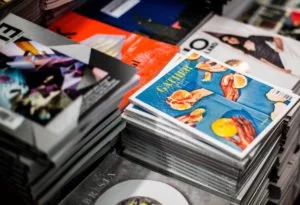When it comes to making the aesthetic difference between an ordinary marketing material and an item that’s both stunning and shiny, foil printing can be the ace in your design arsenal. It’s a unique and quick way to add elegance and sophistication to your project, making it look and feel more luxurious. It’s the perfect embellishment to add a bit of depth to your material without distracting from the overall content.
Even just a bit of gold foil printing or accents are enough to transform your business cards, brochures, mailers, or whatever marketing material that deserves your audience’s attention. Once you figure out how to choose the best paper for your printing project, foil stamps are the finishing touches that will make your project stand out.
Thinking of adding foil design to your printed projects? Learn all about foil printing, its process, types, and benefits in this article.
What is foil printing?
Foil printing, oftentimes called foil stamping, is the process of applying colored foils to a surface for a classy and elegant look. Much like embossed printing, foil printing uses a combination of pressure and heat to stick foil to a printed substrate. It creates beautiful designs and striking graphic texts on various materials. Foil printing is increasing in popularity, especially for those who design wedding stationery.
Foil stamps or foil designs can be the final touch to elevate a project and captivate the interest of audiences. It adds visual appeal and premium quality to any printed material, especially if you use gold foil printing. It can make the difference between a lackluster design and a standout one. From wedding cards and brochures to business cards and stationery, a touch of foil can be all you need to make your printed material pop.
How does foil printing work?
Historically, before the invention of foil stamping machines and digital foil printing, foil stamping was an entirely manual process. For instance, skilled artisans would paint ornamental designs on the covers of books with shiny, molten gold. It was then cold gold leafing or gilding. The process also used real gold, which made it costly. Artisans would hammer gold nuggets into very thin sheets of gold to apply them by hand to various items.
It was in the 1900s that mechanical foil stamping was first introduced by Ernst Oeser, an entrepreneur and bookbinder who invented the modern foil stamping machine. Later in the 1900s, luxurious foils would be made available to the market by George M. Whiley, who layered gold and silver dust on thin sheets of polyester.
Nowadays, gold foil printing uses a die, a thin layer of foil, and a surface to print on. The die, cut into the design’s shape, is heated before it is pressed upon the foil and into the printing surface. The combination of pressure and heat then binds the thin foil layer permanently to the final surface. Embossing and foil printing often complement each other, with both techniques giving projects both a tactile and visual pop.
Different foil printing methods
Now that you know what foil printing is and how it works, let’s move on to the three most common methods of foil stamping.
Traditional Foil Printing
This method starts with the design being etched onto a foiling die, which is a metal plate that can be compared to a conventional rubber stamp. The die is heated up, and a thin layer of foil is placed between the substrate and the die. The foil is then permanently bonded to the surface in the etched design’s shape by applying pressure to the foil and the printing surface.
For designs with multiple colors, each separate die needs to be created for each color, especially with offset printing. Producing the final design will also require several runs of the press foiling machine. So special effects such as gold foil printing and raising can be achieved by using another specialized die.
Digital Foil Printing
Digital foil printing, also known as digital foil stamping, is similar in visual appeal to its traditional counterpart. However, instead of pressing the pattern onto the substrate using a stamping die, the image is printed digitally to the surface by using a special type of foil that adheres to the substrate.
Digital foil printing eliminates the need to use multiple dies in projects that require multiple colors and patterns. Many liken this method to conventional inkjet printing.
Cold Foil Printing
Cold foil printing is a fast and cost-effective method of applying foil to various surfaces and substrates. In the cold foil printing process, the cold foil is applied using a standard printing plate to an adhesive image. The foil is then affixed to the printed adhesive, which will create an image before the application of printing inks. The remaining foil that does not stick to the adhesive stays on a thin polyester liner. Waste is then forwarded to a rewind spool.
Since the adhesive is applied like an ink on press, stamping die is no longer necessary. Once printed, the cold foil images’ surface is often varnished to offer a durable printing surface. As it utilizes a printing plate, the printed inks, applied foil, and varnish are registered in a press perfect manner. Cold foils can be done for silver and gold foil printing, as well as stock and customized holographic patterns.
Different types of foils used for printing
Centuries ago, real silver and gold sheets were widely used for silver and gold foil printing. Today, the use of real gold is expensive and rare. Modern printers, including those who argue between the merits of offset printing vs digital printing, make do with the following foils for stamping:
- Metallic foil – The most commonly used material for foil printing. Metallic foils are tin foils or aluminum mixed with color to appear like precious metals such as silver, gold, and rose gold. As one might expect, they emit a metallic and shiny look. Metallic foils are perfect to elevate your design with a silver or gold finish.
- Pigment foil – Pigment foils lack the metallic look of their metalized counterparts as they create a glossy or matte look as opposed to the sheen of metallic foils. These foils come in nearly every color, making them extremely versatile. They are used on both plastics and papers.
- Pearl foil – Pearl foils are transparent and translucent, producing pearlescent glimmers. They’re mainly used to a lustrous yet subtle shine to a printed material, which is why they’re common on designs of wedding invitations and greeting cards.
- Holographic foil – These foils produce rainbow-colored or 3D patterns, adding an extra flair to collectible items such as credit cards, baseball cards, and promotional materials.
- Scratch-off foil – As its name implies, scratch-off foil is designed to be removed easily via scratching. This type of foil doesn’t adhere permanently to a substrate or printed surface, making them ideal for concealing sensitive information temporarily. Scratch-off foils are typically found on phone cards and lottery tickets.
Benefits of foil printing
Foil prints are the extra flourish any printing project needs to take the design to the next level. It adds visual appeal and sophistication without you needing to break the bank.
Here are the top reasons to incorporate foil designs into your printing projects:
Attention-grabbing aesthetics
Silver and gold are known to be naturally attractive colors. When people see it, they can’t help but gravitate towards the distinctive and eye-catching colors. With silver and gold foil printing, you can make your printed materials stand out and draw more people towards them. The more appealing the print, the more likely your content will be read.
High-quality design
Foil makes any design look high-class, luxurious, and expensive, even if it doesn’t cost a lot to make. If you have a business, you can elevate your brand’s reputation by utilizing silver or gold foil printing in your materials. It will improve the way your brand is perceived by customers. They will see your business as one that’s professional and sophisticated. As the design looks good, recipients are also less likely to ignore your printed materials and throw them away.
Versatility
Foil printing can be sparingly used to create a striking focal point to draw the attention of readers to the most important information on printed material. Or it can be used to build on a large design that improves the luxurious feel of the whole piece. Whichever way you choose to use it, your reader or recipient knows that your printed material is high-quality and worth their time.
Complements other printing techniques
Foil stamping, be it digital foil printing or cold foil printing, is often paired with embossing. This provides a shiny 3D look and feel to printed materials. You can also experiment with various paper types such as high gloss and corrugated cardboard to evoke different experiences for your recipients.
Leverage Foil Stamping for Your Printing Projects
Today, foil stamping is used on a wide array of stationery items and printed materials to create beautiful and striking pieces that capture the attention and hearts of all those who see them. As you can see, foil stamping uses various amazing techniques, materials, and machinery to level up your designs. Foil printing also provides designers and printers with luxurious texture options, allowing for unique features and enhanced aesthetics. While the ideal type of foil materials for your specific application is dependent on the surface finish of your project, you can be sure to find the perfect one to elevate your printing job.


